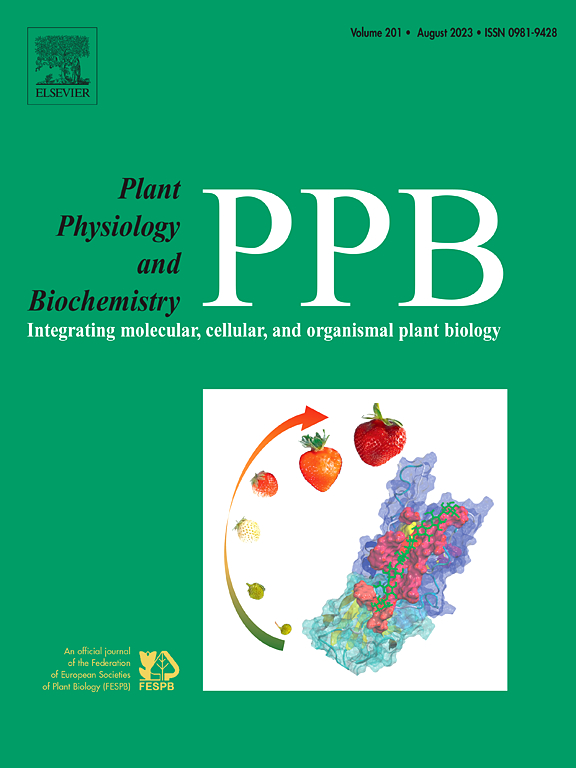Trichoderma atroviride enhances ROS scavenging systems, primary and secondary metabolism increasing the yield of soybean plants
IF 6.1
2区 生物学
Q1 PLANT SCIENCES
引用次数: 0
Abstract
Trichoderma application offers soybean farmers global benefits by enhancing plant growth stimulation and crop yield. Globally, beneficial fungus application rise as more sustainable agricultural practices, improving resilience against climate change impacts. Biostimulants are promising tools for mitigating abiotic stresses and increasing soybean yield. Trichoderma has emerged as an innovative approach for sustainable agricultural solutions. Microorganisms that enhance agricultural production show several important traits in bioprospecting. This study aimed to evaluate the biostimulant effect of Trichoderma isolates on the growth, physiological performance, and yield of soybean plants. Five fungal isolates of Trichoderma atroviride were used. Trichoderma was inoculated as colonized rice incorporated into the soil before soybean sowing, and also applied as a foliar application of conidial suspension at the V3 stage. Parameters related to plant growth, antioxidant and secondary metabolism were determined. The application of isolates dramatically increased the concentration of glyceollin (main phytoalexin) in soybean cotyledons. In addition, all Trichoderma isolates elicited the activity of plant defense-inducing enzymes (POD, PPO, LOX, PAL, chitinase, and β-1,3-glucanase) and antioxidant enzymes (SOD, CAT, and APX) in soybean leaves. The Trichoderma isolates promoted a biostimulant effect increasing shoot and root biomass, and nodulation of soybean plants. Increased nodulation, antioxidant activity, and secondary metabolism resulted in enhanced soybean plant growth, leading to higher globulin concentration in the seeds. These phenomena resulted in increased seed mass and yield of soybean plants. These results suggest the use of Trichoderma for more sustainable agriculture show a great potential to increase soybean yield under field conditions worldwide.
atroviride木霉能增强活性氧清除系统、初级和次级代谢,提高大豆产量
木霉的施用通过提高植物生长刺激和作物产量,为大豆种植者提供了全球效益。在全球范围内,随着更可持续的农业实践,有益真菌的应用增加,提高了抵御气候变化影响的能力。生物刺激素是缓解非生物胁迫和提高大豆产量的有前途的工具。木霉已经成为可持续农业解决方案的一种创新方法。促进农业生产的微生物在生物勘探中显示出几个重要特征。本研究旨在评价分离木霉对大豆植株生长、生理性能和产量的生物刺激素作用。本研究采用了5株阿托维木霉分离株。木霉作为定植水稻在大豆播种前掺入土壤中接种,并在V3期作为分生孢子悬浮液叶面施用。测定了植物生长、抗氧化和次生代谢的相关参数。分离物的应用显著提高了大豆子叶中甘油(主要抗菌素)的含量。此外,所有木霉分离株均能激发大豆叶片中植物防御诱导酶(POD、PPO、LOX、PAL、几丁质酶和β-1,3-葡聚糖酶)和抗氧化酶(SOD、CAT和APX)的活性。分离的木霉具有促进大豆茎、根生物量和结瘤的生物刺激作用。结瘤、抗氧化活性和次生代谢的增加导致大豆植株生长加快,导致种子中球蛋白浓度升高。这些现象导致大豆种子质量和产量增加。这些结果表明,在世界范围内,在田间条件下,利用木霉进行更可持续的农业生产显示出提高大豆产量的巨大潜力。
本文章由计算机程序翻译,如有差异,请以英文原文为准。
求助全文
约1分钟内获得全文
求助全文
来源期刊
CiteScore
11.10
自引率
3.10%
发文量
410
审稿时长
33 days
期刊介绍:
Plant Physiology and Biochemistry publishes original theoretical, experimental and technical contributions in the various fields of plant physiology (biochemistry, physiology, structure, genetics, plant-microbe interactions, etc.) at diverse levels of integration (molecular, subcellular, cellular, organ, whole plant, environmental). Opinions expressed in the journal are the sole responsibility of the authors and publication does not imply the editors'' agreement.
Manuscripts describing molecular-genetic and/or gene expression data that are not integrated with biochemical analysis and/or actual measurements of plant physiological processes are not suitable for PPB. Also "Omics" studies (transcriptomics, proteomics, metabolomics, etc.) reporting descriptive analysis without an element of functional validation assays, will not be considered. Similarly, applied agronomic or phytochemical studies that generate no new, fundamental insights in plant physiological and/or biochemical processes are not suitable for publication in PPB.
Plant Physiology and Biochemistry publishes several types of articles: Reviews, Papers and Short Papers. Articles for Reviews are either invited by the editor or proposed by the authors for the editor''s prior agreement. Reviews should not exceed 40 typewritten pages and Short Papers no more than approximately 8 typewritten pages. The fundamental character of Plant Physiology and Biochemistry remains that of a journal for original results.

 求助内容:
求助内容: 应助结果提醒方式:
应助结果提醒方式:


